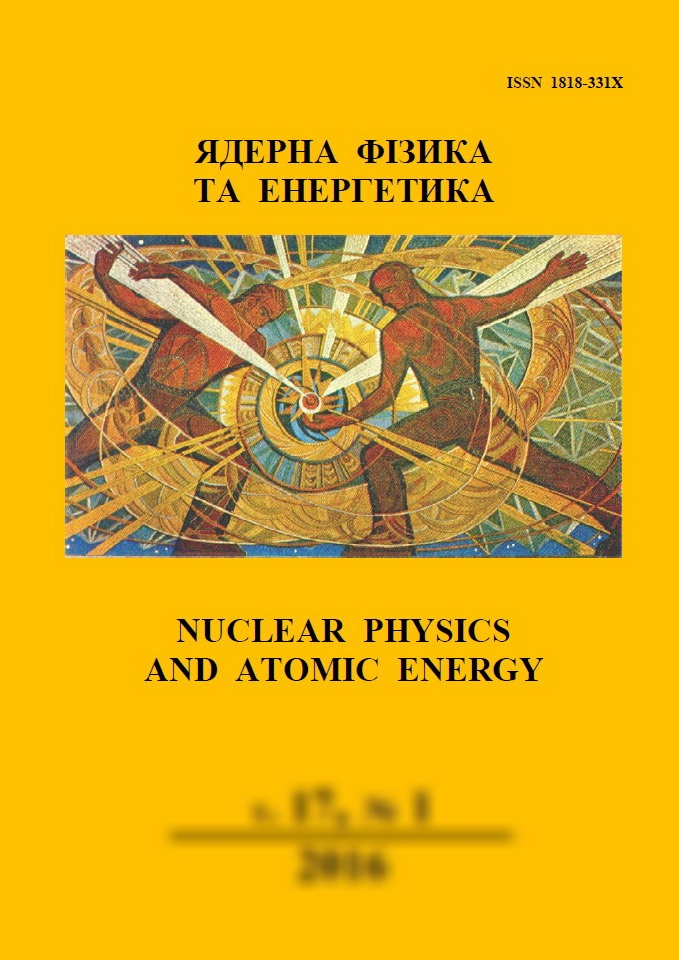 |
ядерна ф≥зика та енергетика
Nuclear Physics and Atomic Energy
ISSN:
1818-331X (Print), 2074-0565 (Online)
Publisher:
Institute for Nuclear Research of the National Academy of Sciences of Ukraine
Languages:
Ukrainian, English
Periodicity:
4 times per year
Open access peer reviewed journal
|
Nucl. Phys. At. Energy 2001, volume 2, issue 1, pages 143-150.
Section: Plasma Physics.
Published online: 30.03.2001.
 Full text (en)
Full text (en)
https://doi.org/10.15407/jnpae2001.01.143
Ion assisted etching: influence of the ion charge sign
S. N. Pavlov
Institute for Nuclear Research of the National Academy of Sciences of Ukraine
Abstract:
The relative influence of the ions of different signs on the ion-assisted etching of silicon is under
investigation. The fluorine radicals are produced by the direct current glow discharge with pressure
gradient. The beam of positive or negative ions is produced by PIG source. The flows of radicals and ion
beam are met on the surface of the silicon placed in high vacuum. The positive ions can be converted into
the fast neutral atoms by method of resonance exchanging in an own gas. It is shown that the fast neutral
atoms have the highest stimulating ability. The catalytic influence of the positive ions is by two times less.
The negative ions have the intermediate parameters. It is found that some kinds of ions (for example,
molecular oxygen) decelerate the etching that is they behave itself like an inhibitor.
References:
1. Hosokawa N., Matsuzaki R. RF Sputter-Etching by Fluoro-Chloro-Hydrocarbon Gases. Japan J. Appl. Phys. Suppl. 2 (1974) 435.
https://doi.org/10.7567/JJAPS.2S1.435
2. Holland L., Ojha S. M. The chemical sputtering of graphite in an oxygen plasma. Vacuum 26 (1976) 53.
https://doi.org/10.1016/S0042-207X(76)80624-0
3. Einspruch N. G., Brown D. M. Plasma Processing for VLSI (Academic Press. Inc. 1984) Vol. 8.
4. Coburn J. W., Winter H. W. Ion- and electron-assisted gas-surface chemistry - An important effect in plasma etching. J. Appl. Physics 50 (1979) 3189.
https://doi.org/10.1063/1.326355
5. Flamm D. L., Donnelly V. M., Ibbotson D. E. Basic chemistry and mechanism of plasma etching. J. Vac. Sci. Technol. B 1 (1983) 23.
https://doi.org/10.1116/1.582536
6. Winters H. F., Coburn J. W. Plasma-assisted etching mechanisms: The implications of reaction probability and halogen coverage. J. Vac. Sci. Technol. B 3 (1985) 1376.
https://doi.org/10.1116/1.582996
7. Donnelly V. M., Layadi N., Lee J. T. C. et. al. Cl2 Plasma - Si Surface Interactions in Plasma Etching: X-ray Photoelectron Spectroscopy After Etching, and Optical and Mass Spectrometry Methods During Etching. Plasma Processing of Semiconductors. NATO ASI Series E 336 (Dordrecht: Kluwer Academic Publishers, 1996) 243.
8. Winter H. F., Coburn J. W. Surface science aspects of etching reaction. Surf. Sci. Rep. 14 (1992) 162.
https://doi.org/10.1016/0167-5729(92)90009-Z
9. Flamm D. L. Plasma Chemistry, Basic Processes, and PECVD. Plasma Processing of Semiconductors. NATO ASI Series E 336 (Dordrecht: Kluwer Academic Publishers, 1996) 23.
https://doi.org/10.1007/978-94-011-5884-8_2
10. Mauer J. L., Logan J. S., Zielinski L. B. Mechanism of silicon etching by a CF4 plasma. J. Vac. Sci. Technol. 15 (1978) 1734.
https://doi.org/10.1116/1.569836
11. Oostra D. J., Haring A., de Vries A. E. et. al. Etching of silicon by SF6 induced by ion bombardment. Nucl. Instr. and Meth. B 13 (1986) 556.
https://doi.org/10.1016/0168-583X(86)90565-3
12. Kireev V. U., Kremerov M. A. Electron-assisted radical etching. Electronic Technique Ser. 3 Microelectronic 1 (1985) 3.
13. Keller J. H. New and possible future trends in inductively coupled plasmas (ICPs) for semiconductor processing. Plasma Phys. Control. Fusion 39 (1997) A437.
https://doi.org/10.1088/0741-3335/39/5A/041
14. Danilina T. I., Ivanov E. V., Kreyndel. Compact source of oxygen negative ions. Devices and Experimental Technique 3 (1968) 158.
15. Ioffe M. C., Sobolev R. I., Telkovsky V. G., Ushmanov E. E. Investigation of plasma confinement in a mirror trap. JETF 3 (1960) 1602.
16. Fite W. L., Brackman R. T., Snow W. R. Charge Exchange in Proton-Hydrogen-Atom Collisions. Phys. Rev. 112 (1958) 1161.
https://doi.org/10.1103/PhysRev.112.1161
17. Gerlach-Meyer U., Coburn J. W., Kay E. Ion-enhanced gas-surface chemistry: the influence of the mass of the incident ion. Surface Science 103 (1981) 177.
https://doi.org/10.1016/0039-6028(81)90106-0
18. Hagstrum H. D. Auger Ejection of Electrons from Molybdenum by Noble Gas Ions. Phys. Rev. 104 (1956) 672.
https://doi.org/10.1103/PhysRev.104.672
19. Hagstrum H. D., Takeishi Y., Pretzer D. D. Energy Broadening in the Auger-Type Neutralization of Slow Ions at Solid Surfaces. Phys. Rev. 139 (1965) A526.
https://doi.org/10.1103/PhysRev.139.A526
20. Behrish R. Sputtering by Particle Bombardment (Berlin - New York: Springe-Verlag, 1981) Chap. 2.
